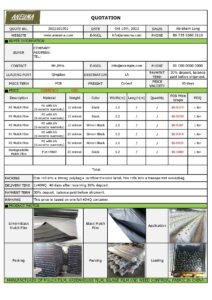In recent years, environmental concerns have led to a growing interest in sustainable agriculture practices. One such innovation making waves in the farming community is biodegradable mulch film. This eco-friendly alternative to traditional plastic mulch film offers numerous benefits while mitigating the environmental impact associated with conventional methods. In this article, we will explore why biodegradable mulch film is an eco-friendly solution, compare it to traditional plastic mulch, and examine its usage worldwide, as well as the factors hindering its widespread adoption by growers.

Why is Biodegradable Mulch Film Eco-Friendly?
The primary reason biodegradable mulch film is considered eco-friendly lies in its biodegradability and reduced environmental impact. Unlike traditional plastic mulch, which can persist in the soil for years, biodegradable mulch films are designed to break down naturally over time. These films are typically made from plant-based materials, such as starch, polylactic acid (PLA), or polyhydroxyalkanoates (PHA), which are derived from renewable resources. As a result, they do not contribute to plastic pollution, nor do they require extensive cleanup after the growing season.
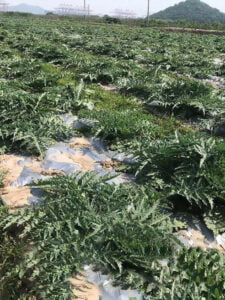
When the biodegradable mulch film breaks down, it decomposes into non-toxic components that are assimilated into the soil, enriching its organic content. This process enhances soil structure, promotes microbial activity, and helps retain moisture, ultimately benefiting crop growth. Moreover, the absence of non-degradable plastic residues reduces the risk of soil contamination, safeguarding ecosystems and biodiversity.
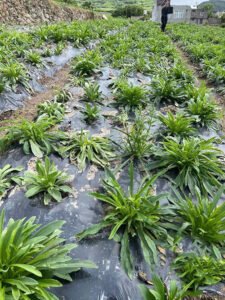
Our bio-degradable mulching film has been produced and applied to all over China and other countries in the past 10 years for various crops. They have been approved a great substitution of the traditional mulch film. Please refer to our product page to study the details including degrade phase, images, data etc.
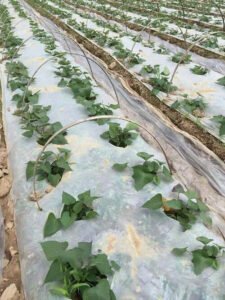
Comparison with Traditional Plastic Mulch Film
- Environmental Impact: The environmental impact of traditional plastic mulch film is a significant concern. It contributes to plastic waste in landfills and can find its way into water bodies, harming aquatic life. Biodegradable mulch film offers a more sustainable option by breaking down into harmless natural components.
- Cost and Labor: Traditional plastic mulch requires removal and disposal after the growing season, which adds to labor and disposal costs. Biodegradable mulch eliminates this step, reducing labor and waste management expenses.
- Soil Health: Plastic mulch can hinder water infiltration and gas exchange, leading to soil compaction and reduced fertility. Biodegradable mulch, on the other hand, enhances soil health by encouraging microbial activity and improving nutrient cycling.
- Temperature Regulation: Biodegradable mulch film has shown better temperature-regulating properties, protecting plants from extreme heat or cold, compared to plastic mulch.

Usage Worldwide and Barriers to Adoption
Biodegradable mulch films have gained popularity in various regions worldwide, particularly in Europe, North America, and parts of Asia. European countries have been at the forefront of adopting sustainable agricultural practices, and the availability of government incentives and grants has further promoted the use of biodegradable mulch films.
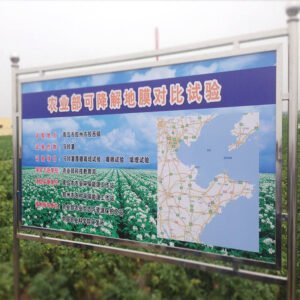
However, some factors have limited the widespread adoption of biodegradable mulch films by growers:
- Cost: Biodegradable mulch films are currently more expensive than traditional plastic mulch. The higher cost of production and limited availability of raw materials contribute to this price difference. As a result, many growers, especially small-scale farmers, find it challenging to invest in biodegradable mulch films.
- Performance: While biodegradable mulch films have shown promising results in research settings, their performance in real-world agricultural conditions can vary depending on factors such as climate, soil type, and crop variety. Some growers remain skeptical about their efficacy, particularly for long-duration crops.
- Lack of Awareness: In many regions, growers may not be aware of the benefits and availability of biodegradable mulch films. Education and outreach efforts are essential to promote their understanding and encourage their adoption.
- Infrastructure and Collection: Proper disposal of biodegradable mulch films is crucial to maximize their environmental benefits. However, an infrastructure for collecting and processing these films at the end of the growing season may be lacking in some areas, discouraging growers from using them.
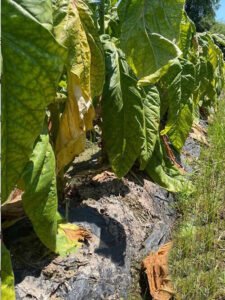
Summary
Biodegradable mulch film represents a promising eco-friendly solution to the environmental challenges posed by traditional plastic mulch. Its ability to break down naturally, enrich soil health, and mitigate plastic pollution makes it an attractive option for sustainable agriculture. While its adoption is growing in various parts of the world, barriers such as cost, performance concerns, and lack of awareness remain to be addressed. Collaborative efforts among governments, agricultural institutions, and manufacturers can play a pivotal role in driving the wider adoption of biodegradable mulch films and ushering in a more sustainable era for farming practices.

